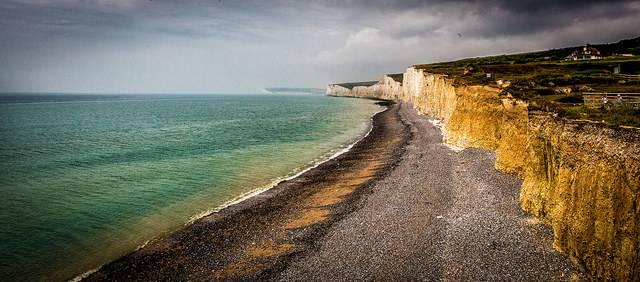
Some Republican politicians aren’t sure whether human activity is the reason for climate change. However, a new study by an Australian climate change expert finds that humans are causing changes to the climate 170 times faster than natural phenomena. And the changes caused by all of the greenhouse gases pumped into the atmosphere are threatening historical and tourist sites around the world, including in Britain.
Over the past decade, a dozen significant sites around Britain -- including landscapes and historic buildings -- have been damaged by severe flooding caused by warmer and wetter weather, according to a report released last week by Leeds University and the Climate Coalition.
Titled “Weather Warning,” the report contains 12 case studies that show how some of Britain’s favorite places are being affected by climate change.
Some face more damage from climate change than others. Birling Gap in East Sussex, England (above), part of the Seven Sisters chalk cliffs, is one of the hardest hit.
The Birling Gap sees 250,000 visitors a year. But over time, the chalk deposits in the area have “seen steady levels of erosion,” the report states, due to the coastline’s geology. The cliffs lost about 67 centimeters a year over the last 50 years, experts determined using monitoring data. And the erosion at Birling Gap has accelerated in recent years.
During the winter storms in 2013 and 2014, the equivalent of seven years of erosion occurred in only two months. The report attributes the increased and accelerated erosion to “a combination of climate change and an increase in the regularity of storm events during this period.”
After the storms in 2013 and 2014, the National Trust -- the owner of the land -- found the visitor center, sun lounge area and ice cream parlor only five meters from the cliff edge. So, they had to take them all down. The Birling Gap Hotel may start to topple off the edge of the cliff in 40 years, based on estimates using the current erosion rate. It is projected that the land underneath the hotel could vanish in 93 years.
Birling Gap is one of the National Trust’s “coastal hotspots” that is at risk due to climate change. And the Trust is having to adapt the site to mitigate these risks. It is doing so by putting in ‘elephants feet’ fencing that can be moved backward as the cliff continues to erode to help manage the danger of falling fences. Steps down to the beach have been added, and the horizontal gangway leading to the steps not only allows visitors to have scenic views, but can also be extended. The whole structure can be moved and repositioned as the cliffs erode. There is a longer term plan to move the infrastructure on the site to somewhere that is less at risk of erosion.
Other at-risk places highlighted in the report include William Wordsworth’s childhood home, a historic pub, a church and a cricket club.
These risks show that tackling climate change is urgent. And some businesses and countries are doing what they can, as the report mentions. One of them is Lord’s Cricket Ground, which is the first national sporting venue in Britain to run on 100 percent renewable energy, including solar photovoltaic panels. Across the English Channel, all electric trains in the Netherlands run on wind as of Jan. 1.
What these examples remind us is that although the current American president may pull the U.S. out of the Paris climate agreement, that will not stop other countries and businesses from doing what they can to tackle the most important issue of our day. And when treasured places begin to change forever due to our warming climate, the political will to mitigate the risk will only increase.
Image credit: Flickr/David D'Amico

Gina-Marie is a freelance writer and journalist armed with a degree in journalism, and a passion for social justice, including the environment and sustainability. She writes for various websites, and has made the 75+ Environmentalists to Follow list by Mashable.com.














